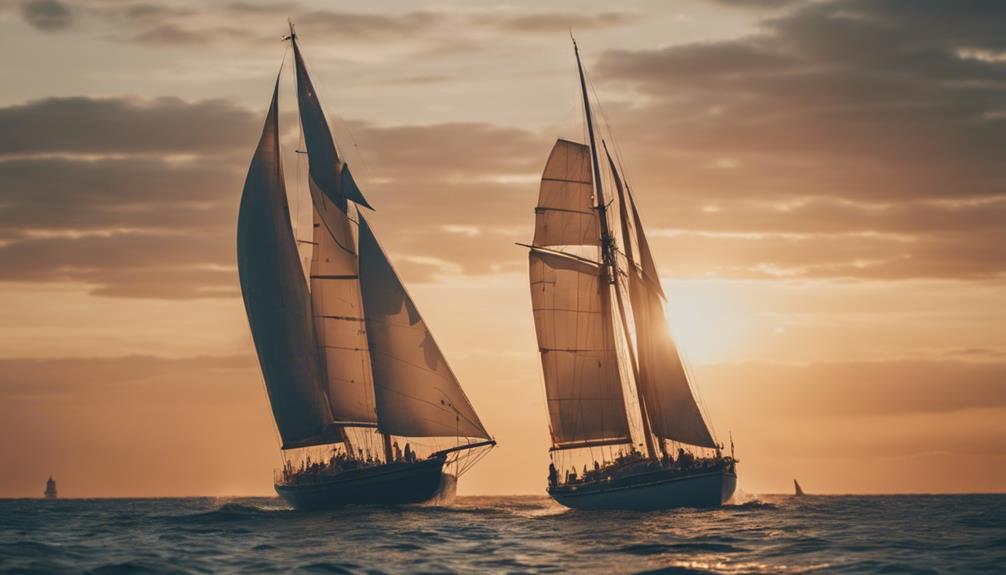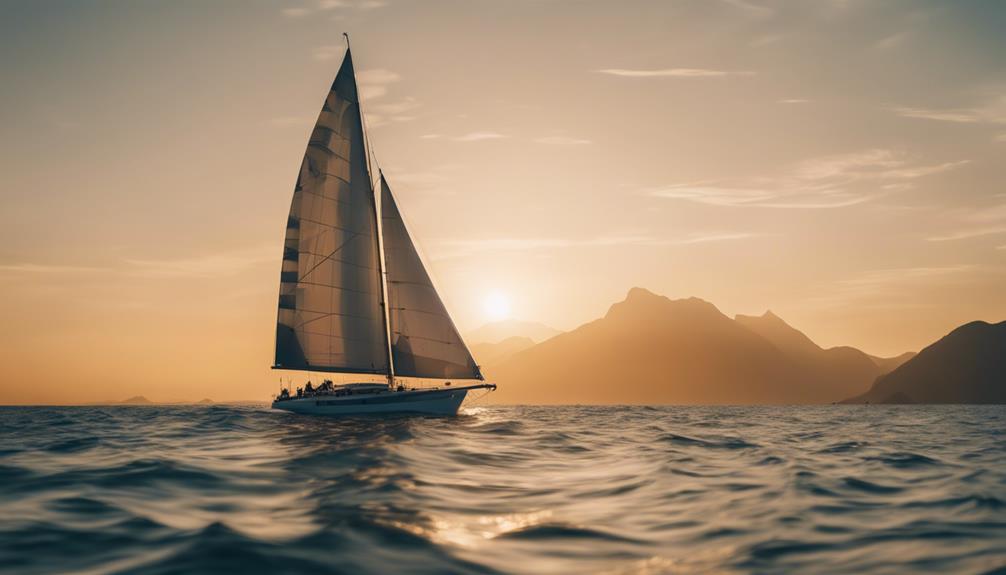The longest sailboat in the world is currently Sailing Yacht A, stretching an impressive 142 meters. Launched in 2017, this architectural marvel, built by Nobiskrug, redefines luxury sailing. Following closely is Koru at 127 meters, commissioned by Jeff Bezos, showcasing a blend of classic design and modern technology. Not far behind, you'll find Black Pearl, measuring 106.7 meters, known for its solar-powered capabilities. Each of these vessels represents a leap in yacht design and craftsmanship, pushing boundaries of both size and innovation. Stick around to discover even more about these incredible maritime achievements.
Key Takeaways
- The longest sailing yacht is Sailing Yacht A, measuring 142 meters, launched in 2017 and built by Nobiskrug.
- Koru, commissioned by Jeff Bezos, is the second-largest sailing yacht at 127 meters, completed in 2023.
- Black Pearl, at 106.7 meters, features advanced solar power capabilities and a unique rigging system for efficient sailing.
- Eos, measuring 92.93 meters, combines sleek design with luxurious amenities, launched in 2006 by Lurssen.
Overview of Record Holders
When it comes to the longest sailing yachts, Sailing Yacht A leads the pack with its impressive length of 142 meters. Launched in 2017 and built by Nobiskrug in Germany, this yacht holds the world record for the largest sailing yacht.
Following closely behind is Koru, measuring 127 meters and commissioned by Jeff Bezos, which was completed in 2023. Koru's design and size have already made waves in the sailing community.
Next in line is the Black Pearl, a striking 106-meter yacht that was delivered in 2018. Known for its advanced solar power capabilities, Black Pearl combines luxury with sustainability, making it a notable contender in the sailing world.
Another impressive sailing yacht is the Eos, which measures 92.93 meters and was built by Lurssen in 2006. With its sleek design and luxurious amenities, Eos is a favorite among sailing enthusiasts.
Finally, the classic Athena, at 90 meters, showcases the beauty of early 20th-century sailing ships while incorporating modern performance features.
These record holders represent the pinnacle of luxury sailing, each with its unique charm and innovation.
Largest Sailing Yachts

When you think about the largest sailing yachts, Koru stands out as the current record holder at 127 meters.
You'll also find remarkable designs in other giants like Black Pearl and Eos, each boasting unique features that enhance performance and luxury.
Let's explore these impressive vessels and what makes them so special.
Current Record Holders
The current record holders for the largest sailing yachts showcase impressive engineering and luxurious designs, with Koru leading the pack at 127 meters (417 feet). This magnificent vessel, built by Oceanco in 2023, raises the bar for sailing yachts worldwide. Following Koru is Black Pearl, measuring 106.7 meters (348 feet) and launched in 2018, known for its advanced solar power generation and unique DynaRig system.
Here's a quick overview of the current record holders:
| Yacht Name | Length (meters) | Year Launched |
|---|---|---|
| Koru | 127 | 2023 |
| Black Pearl | 106.7 | 2018 |
| Eos | 92.93 | 2006 |
| Athena | 90 | 2004 |
| Maltese Falcon | 88 | 2006 |
Eos, at 92.93 meters (305 feet), is known for its luxurious design, while Athena impresses with its classic style and speed of up to 19 knots. Maltese Falcon, measuring 88 meters (288 feet), features the innovative DynaRig system, making it a standout in the sailing world.
Notable Design Features
Notable design features of the largest sailing yachts highlight a blend of luxury, performance, and innovation that sets them apart on the open seas.
The Koru, the largest yacht ever built at 127 meters, boasts a classic design with towering masts that elevate its grandeur.
Black Pearl, measuring 106 meters, showcases innovative design features, including solar power generation that enhances its eco-friendliness and a unique rigging system that allows for rapid sail deployment.
Eos, at 92.93 meters, combines sleek aesthetics with a spacious deck layout, making it perfect for both relaxation and performance.
The three-masted gaff rig of Athena, measuring 90 meters, not only allows for impressive speeds of up to 19 knots but also accommodates luxurious interiors for guests.
One of the most innovative aspects of the Maltese Falcon, at 88 meters, is its DynaRig system featuring automated sail management. This cutting-edge technology enables it to reach speeds of 25 knots while providing opulent accommodations for 12 guests.
These remarkable design features reflect the ongoing evolution of new sailing yachts, making them stand out in the marine world.
Historical Context of Yachting

When you think about the historical context of yachting, you can't ignore how yacht design has evolved over the years, reflecting advancements in technology and materials.
Milestones in sailing records have transformed the competitive landscape, pushing the boundaries of what's possible on water.
Understanding these developments helps you appreciate the impact they've had on modern sailing practices today.
Evolution of Yacht Design
Yacht design has transformed dramatically over the years, reflecting advancements in materials and technology that enhance both performance and luxury on the water.
From the shift to metal shipbuilding in the late 19th century, which improved durability, to the introduction of carbon fibre masts, modern yachts have evolved considerably. Historical yachts like the Atlantic set speed records, influencing today's naval architecture principles focused on aerodynamics.
The Royal yacht tradition has also shaped design, emphasizing both elegance and functionality. Today's yachts are built not just for sailing but for comfort and luxury, with spacious interiors and high-end amenities.
You'll find that the ten largest sailing yachts, such as the Maltese Falcon, exhibit innovations like the DynaRig system, which revolutionizes sailing efficiency and handling.
Recent models, including Koru and Eos, showcase this blend of speed and luxury, marking a new era in yacht design.
The result is a world where yachting isn't only about the journey but also about the experience on board, as designers continue to push the boundaries of what's possible on the water.
Milestones in Sailing Records
Throughout the history of yachting, numerous milestones have marked remarkable achievements in sailing records, showcasing human ingenuity and the spirit of adventure on the open sea. Here are a few key highlights:
- The Atlantic, launched in 1903, set a record for the fastest transatlantic crossing in 1905, a benchmark that stood unbroken for nearly a century.
- The Phocea, introduced in 1976, claimed the title of the longest sailing ship until 2004, enchanting enthusiasts with its luxurious design and extensive refits.
- The Maltese Falcon, launched in 2006, transformed sailing with its innovative DynaRig technology, allowing for unparalleled sail management and performance.
- The Mirabella V, measuring an impressive 247 feet, features the world's largest mast and showcases significant advancements in modern yacht design since its debut in 2004.
These milestones not only highlight individual vessels but also reflect the evolving nature of sailing records.
Each achievement contributes to the rich tapestry of yachting history, inspiring future generations to push the boundaries of what's possible on the open sea.
Impact on Modern Sailing
The evolution of sailing, shaped by historical achievements and technological advancements, continues to influence modern practices and designs in the sport today.
As you explore modern yacht design, you'll see how the shift from wooden ships to iron and steel vessels paved the way for enhanced durability and speed. Record holders like the original Atlantic, which set a fast Atlantic crossing record in 1905, have established performance metrics that today's sailors aspire to achieve.
Notable races, such as the Vendée Globe and The Ocean Race, push technological boundaries, inspiring innovations in advanced rigging systems and the use of lightweight materials. These advancements are essential for enhancing the performance of contemporary vessels. You might notice how designs like the Maltese Falcon and Black Pearl seamlessly blend historical influences with cutting-edge technology.
Additionally, the accomplishments of pioneering female sailors have helped diversify the community and inspire new generations. By recognizing these milestones, you can appreciate how the legacy of sailing continues to shape modern practices, making the sport more accessible and competitive than ever before.
Yacht Design Innovations

Innovative designs in sailing vessels are pushing the boundaries of both performance and sustainability, making modern yachts more efficient and luxurious than ever. You'll find that the latest yacht design innovations combine cutting-edge technology with stunning aesthetics.
Here are some remarkable examples:
- Maltese Falcon: This 88m marvel features a DynaRig system with automated square sails for peak performance across various wind conditions.
- Black Pearl: At 106m, it harnesses solar power, boasting a sail area of over 31,000 square feet that can be deployed in under 7 minutes, showcasing sustainable yacht design.
- Koru: The tallest sailing yacht at 127m merges classic beauty with modern tech through its towering masts, exemplifying the balance of tradition and innovation.
- Aquijo: This 86m ketch stands out with advanced rigging systems and a beamy design, emphasizing luxury while enhancing performance.
These yachts demonstrate how the maritime world is evolving, prioritizing both comfort and ecological responsibility. Together, they represent the future of sailing, where performance meets sustainability in extraordinary ways.
Notable Sailing Achievements

Recent advancements in yacht design have paved the way for remarkable sailing achievements that push the limits of performance and endurance on the water.
The Sailing Yacht A, the longest sailing yacht at 142 meters, showcases cutting-edge sailing yacht technology with its three towering 100-meter carbon fiber masts. Following closely is Koru, the second-largest sailing yacht, measuring 127 meters and commissioned by Jeff Bezos, highlighting the trend toward larger and more luxurious vessels.
Among record holders, the Black Pearl stands out not just for its size at 106.7 meters but also for its unique Dynarig setup, which enhances energy efficiency. This innovation has redefined how we perceive performance in sailing. The Maltese Falcon, measuring 88 meters, was a trailblazer in sailing yacht technology, being the first to incorporate an automated DynaRig system.
Historically, notable sailing achievements include the Atlantic, which set the speed record for the fastest transatlantic crossing in 1905, a feat that remained unmatched for almost a century. These milestones illustrate the ongoing evolution and excitement within the world of sailing.
Future Trends in Sailing Yachts

As yacht designers embrace eco-friendly technologies, the future of sailing yachts is set to transform with sustainable innovations that prioritize both performance and environmental responsibility. You can expect some exciting trends shaping the industry:
- Solar Power Integration: Yachts will harness solar power, reducing reliance on fossil fuels and enhancing sustainability.
- Hybrid Propulsion Systems: Combining traditional sails with hybrid systems will improve efficiency and extend cruising ranges without harming the environment.
- Advanced Materials: The use of lightweight materials like carbon fiber and aluminum will enhance sailing performance while ensuring structural integrity.
- Multi-Functional Onboard Spaces: Expect custom-built yachts featuring luxurious amenities such as gyms, spas, and entertainment areas, maximizing comfort and versatility.
Moreover, innovations in rigging systems will simplify sailing, making it easier for both small crews and solo sailors to manage their vessels.
As these trends evolve, you're not just investing in a yacht; you're embracing a lifestyle that champions sustainability and performance. The future of sailing is bright, and it's all about harmonizing luxury with responsibility.
Frequently Asked Questions
Who Owns the Largest Sailboat on Earth?
You'll find that the largest sailboat on Earth is owned by Jeff Bezos. His yacht, Koru, measures 127 meters and features impressive masts, showcasing his dedication to luxury and innovation in sailing.
What Is the Longest Sailboat in the World?
You'll find that the longest sailboat in the world is Mirabella V, stretching 247 feet long. It boasts the tallest mast at 88.3 meters, making it a standout in the sailing community.
What Is the Guinness World Record for Sailing Around the World?
You wouldn't believe the speed! The Guinness World Record for sailing around the world is held by IDEC Sport, which completed this incredible journey in just 40 days, 23 hours, and 30 minutes—non-stop and solo!
How Many People Have Sailed Solo Nonstop Around the World?
As of now, only three sailors have successfully completed solo, non-stop circumnavigations of the globe in both directions. It's a remarkable achievement that showcases their incredible skill and determination in overcoming extreme challenges.
What are the advantages of having a large sailboat for global records?
The largest sailboat recordholders have the advantage of being able to withstand the harsh conditions of global voyages. With more space and stability, these large sailboats can carry extra equipment and provisions, making them ideal for long-distance expeditions and setting world records for sailing accomplishments.
Conclusion
As you navigate the world of sailing yachts, it's fascinating to see how the longest boats have evolved, reflecting both innovation and tradition.
Picture a majestic yacht slicing through waves, its sails catching the wind just right, echoing the triumphs of past sailors.
These record holders aren't just vessels; they're symbols of human ingenuity and adventure.
With each new design, you're witnessing the future of sailing unfold, promising even grander achievements on the horizon.










